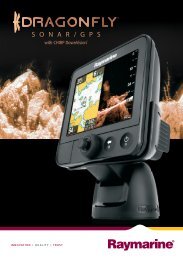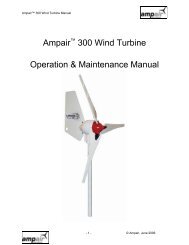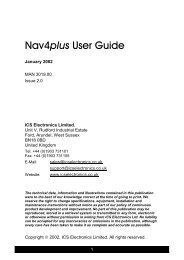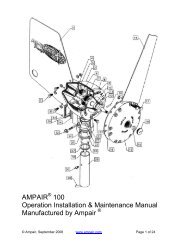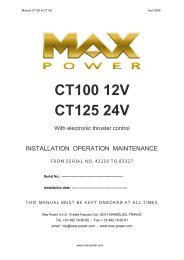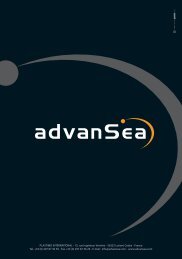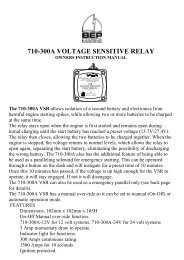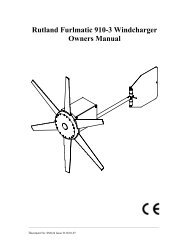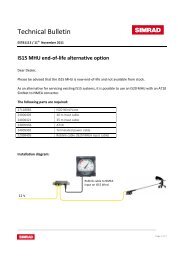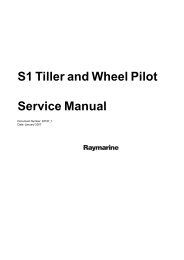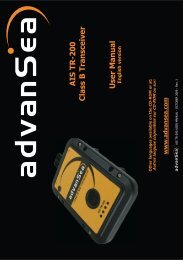User manual - JG Technologies
User manual - JG Technologies
User manual - JG Technologies
You also want an ePaper? Increase the reach of your titles
YUMPU automatically turns print PDFs into web optimized ePapers that Google loves.
9.1 Chart application overview<br />
The chart application provides an electronic chart with passage<br />
planning and navigation features. It combines 2D and 3D viewpoints<br />
and provides a variety of cartographic information regarding your<br />
surroundings and charted objects.<br />
Typical uses for the chart application include :<br />
• Monitor your vessel location and heading.<br />
• Interpret your surroundings.<br />
• Measure distance and bearing.<br />
• Navigate using waypoints.<br />
• Plan, and Navigate using routes.<br />
• Monitor fixed and moving objects using radar overlay.<br />
• Monitor vessels in your vicinity using AIS data.<br />
• Keep track and record your course.<br />
• View information for charted objects.<br />
• Overlay NOWRad weather information.<br />
• Overlay aerial photos and other chart enhancements<br />
Note: To obtain full 3D detail, you must have chart cards<br />
containing 3D cartography for the appropriate geographic area.<br />
You can also use your multifunction display to customize your chart<br />
application to your own particular requirements and circumstances.<br />
You can:<br />
• Alter the way the chart is drawn in relation to your vessel and the<br />
direction you are travelling in (chart orientation and motion mode).<br />
• Manage and edit chart data you have entered.<br />
• Control the level of detail displayed on-screen.<br />
Chart datum<br />
The chart datum setting affects the accuracy of the vessel position<br />
information displayed in the chart application.<br />
In order for your GPS receiver and multifunction display to correlate<br />
accurately with your paper charts, they must be using the same<br />
datum.<br />
The default datum for your multifunction display is WGS1984. If<br />
this is not the datum used by your paper charts, you can change<br />
the datum used by your multifunction display, using the system<br />
preferences page. The system preferences page can be accessed<br />
from the homescreen: Set-up > System Settings > System<br />
Preferences > System Datum.<br />
When you change the datum for your multifunction display, the<br />
chart grid will subsequently move according to the new datum, and<br />
the latitude/longitude of the cartographic features will also change<br />
accordingly. Your multifunction display will attempt to set up any<br />
GPS receiver to the new datum, as follows:<br />
• If your multifunction display has a built in GPS receiver it will<br />
automatically correlate each time you change the datum.<br />
• If you have a Raymarine GPS receiver using SeaTalk or<br />
SeaTalk ng , it will automatically correlate each time you change the<br />
datum on the multifunction display.<br />
• If you have a Raymarine GPS receiver using NMEA0183, or a<br />
third-party GPS receiver, you must correlate it separately.<br />
It may be possible to use your multifunction display to correlate<br />
an NMEA0183 GPS receiver. From the homescreen go to Set-up<br />
> System settings > GPS Set-up > View Satellite Status. If the<br />
datum version is displayed, it may be possible to change it. From<br />
the homescreen go to Set-up > System settings > Data Sources<br />
> GPS Datum.<br />
Note: Raymarine recommends that you check the displayed<br />
vessel position in the chart application against your actual<br />
proximity to a known charted object. A typical GPS has an<br />
accuracy of between 5 and 15 m.<br />
Chart cards overview<br />
Chart cards provide additional cartographic information.<br />
Obtain detailed cartographic information for the area that<br />
you navigate using Navionics® chart cards. To check the<br />
current availability of Navionics chart card types, please<br />
visit www.navionics.com or www.navionics.it. The amount of<br />
cartographic detail shown varies for different areas and for different<br />
scales. The chart scale in use is indicated by a number and a<br />
horizontal line in the status bar — the number represents the<br />
distance the horizontal line represents in nautical miles horizontally<br />
across the chart.<br />
You can remove and insert chart cards while a chart is displayed<br />
provided that you follow the correct procedure. The chart information<br />
is retained on-screen until the chart application redraws the screen;<br />
for example, when you pan outside the current area, or use the<br />
Range control to change the chart scale.<br />
Caution: Care of chart and memory<br />
cards<br />
To avoid irreparable damage to and / or loss of data<br />
from chart and memory cards:<br />
• Ensure that chart and memory cards are fitted the<br />
correct way around. DO NOT try to force a card into<br />
position.<br />
• DO NOT save data (waypoints, routes, and so on)<br />
to a chart card, as the charts may be overwritten.<br />
• DO NOT use a metallic instrument such as a<br />
screwdriver or pliers to insert or remove a chart or<br />
memory card.<br />
• Safe removal. Always power the unit off before<br />
inserting or removing a chart or memory card.<br />
Chart compatibility<br />
Your multifunction display is supplied with a base map and<br />
depending on unit a Navionics chart card. You may also purchase<br />
Navionics chart cards to get enhanced chart details and additional<br />
chart features.<br />
Your multifunction display is compatible with the following Navionics<br />
chart cards:<br />
• Ready to Navigate<br />
• Silver<br />
• Gold<br />
• Gold+<br />
• Platinum<br />
• Platinum+<br />
• Fish’N Chip<br />
• Hotmaps<br />
Note: Refer to the Raymarine website (www.raymarine.com) for<br />
the latest list of supported chart cards.<br />
96 e7 / e7D / e95 / e97 / e125 / e127 / c95 / c97 / c125 / c127




